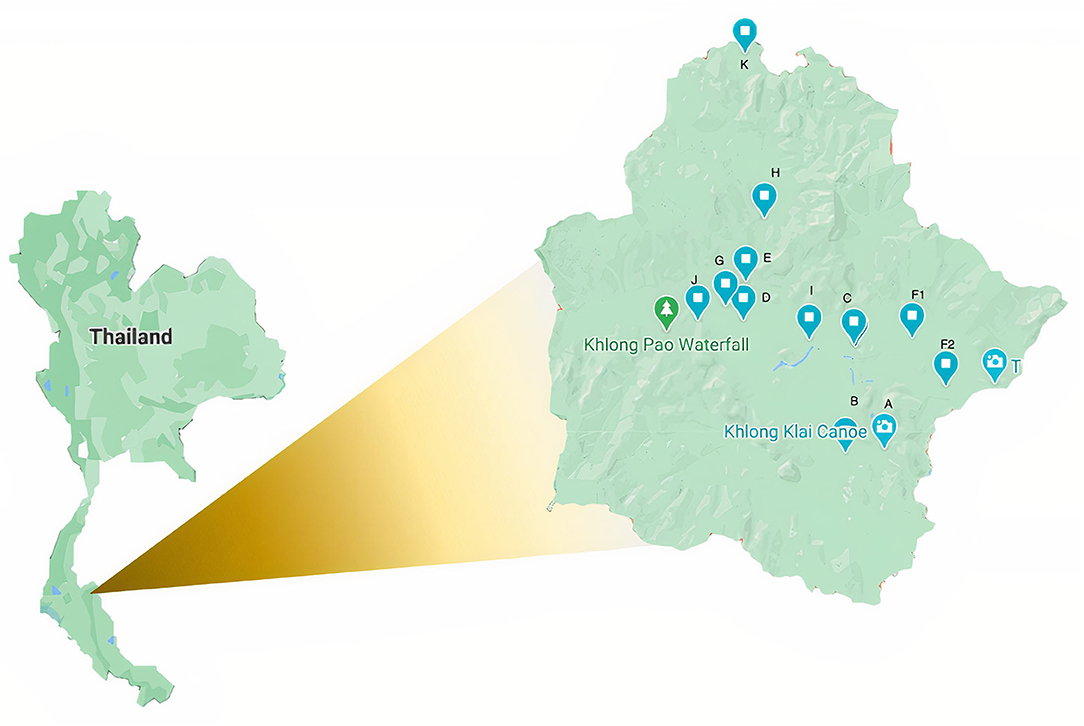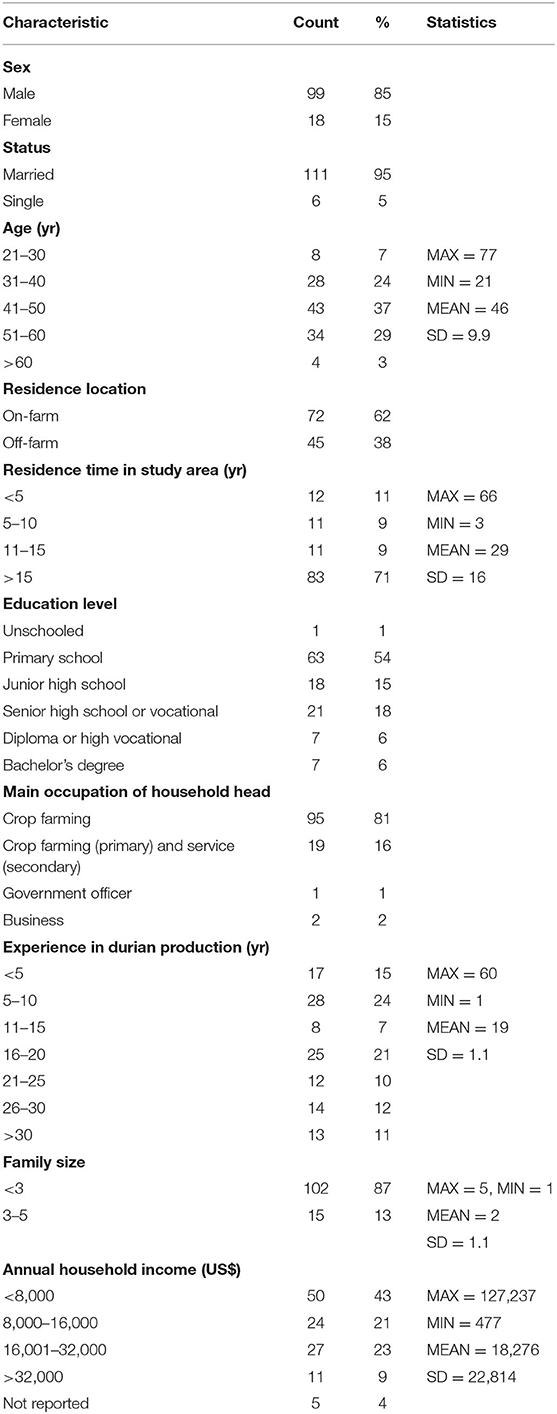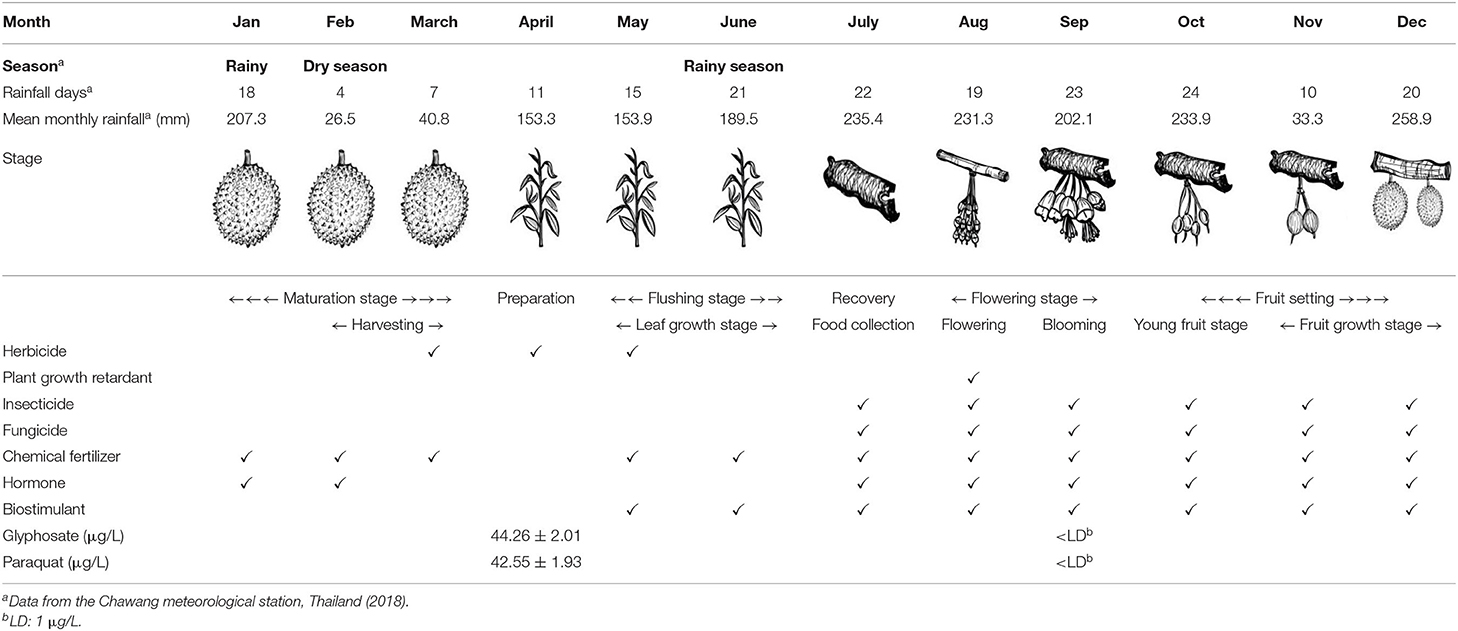- School of Public Health, Walailak University, Nakhon Si Thammarat, Thailand
Rising demand for off-season durian production in Thailand has led to increased agrichemical use and potential environmental and health concerns. In this study, we surveyed 117 farmers and collected water samples from 11 villages in Krungching Sub-district. Overall, 108 agrochemicals were listed as being used in off-season durian production, but we focused on residual concentrations of the persistent herbicides glyphosate and paraquat in surface water. We applied a pollution release and transfer registry for 2016 to determine an application rate of 288,149 kg/year for these agrichemicals. These were primarily detected during the dry season, and not the wet season. This reporting system can be used to develop seasonal environmental surveillance and monitoring tools for more sustainable use of agrochemical substances in off-season durian production in environmentally sensitive areas such as the Krungching River watershed, especially during the first stage of cultivation (dry season), in order to ensure the use of agricultural chemicals under appropriate circumstances. Further studies are needed to better understand the full diversity of persistent agrochemical substance usage and disposal, in order to reorient agricultural activities to focus on local needs and capabilities as part of efforts to implement more sustainable agriculture in Thailand.
Introduction
Agriculture is an important sector of Thailand's economy, accounting for 8.12% of its GDP and ~30% of its workforce (including related sectors) (Statista, 2021; Trading Economics, 2021). Its fruit exports (now the world's sixth-largest) rose 41% in 2019, with the most popular being tropical fruits such as mangosteen, longan, and durian (Datawheel, 2021). The latter is the most famous fruit in Southeast Asia and a very high-value crop, of which Thailand is the world's largest producer and exporter. In 2019, Thai durian cultivation accounted for 1,268.86 km2 and 1,111,928 ton, of which 676,423 ton of fresh durian and derivative products were exported at a value of US$ 2.468 billion (Thailand Ministry of Agriculture Cooperatives, 2021). Although high market demand encourages commercial cultivation, durian's harvest season in Thailand is naturally restricted to a short period from June to July; hence, efforts have been made to extend this using modern technology and various agrochemicals in order to achieve year-round availability to consumers (Hau and Hieu, 2017).
Modern-day agricultural practices often require high levels of agrochemical substances, as farmers seek to avoid damage by insects or diseases that can lead to lost output, resulting in high pesticide (mainly herbicide and insecticide) surpluses that are transferred to water bodies through various diffusion processes. Off-season fruit production significantly increases the intensity of pesticide use because the required pattern of agrochemical usage differs from in-season production (Mahmoud and Shively, 2004). Total agrochemical release is thus multiplied by a factor related to the proportion of the cropping cycle. For example, off-season tomato production by small farmers in Bangladesh resulted in a 56% increase in pesticide use from an initial rate of 3.3 kg/ha (Schreinemachers et al., 2016).
The use of agricultural pesticides in Southeast Asia has skyrocketed during the last 20 years. Pesticides have become so easily available that a pesticide retailer can now be found in nearly every village in Thailand and Vietnam, where annual growth in agricultural pesticide use has risen 7–10% annually for over 10 years. Thailand relies heavily on agrochemicals, especially pesticides, as powerful tools for crop protection in order to increase crop yield and quality. The volume of pesticides imported into Thailand has increased remarkably over time: data from the Thai Department of Agriculture (DOA) show that 98,254.85 ton of pesticide, including 57,007.43 ton of herbicide, 18,946.01 t of insecticide, and 15,176.71 t of fungicide, were imported into Thailand in 2020. Of these, ~26% were classified by the World Health Organization (WHO) as classes Ib (highly hazardous) and II (moderately hazardous) (Thailand Department of Agriculture, 2021). Thailand's increase in pesticide use can mainly be attributed to rising herbicide applications, of which glyphosate and paraquat (which have been restricted in several countries but not in Thailand) accounted for 53% of all use in 2010 (Fröhlich et al., 2013).
Herbicides are frequently found in agricultural runoff, resulting in significantly less safe freshwater for human use (Smith and Pollard, 1998). The concentrations of herbicide in various environmental settings have been extensively documented. For example, annual agricultural activities (including herbicide application) around Gella, Nigeria have resulted in high herbicide residues in reservoir water, such as residual concentrations of paraquat ranging from 63.5 to 87.5 × 10−3 mg/L (Sudi, 2017). In Thailand, when farmers start producing cash crops such as maize, they also tend to start applying mineral fertilizers. As intensification continues and higher-value exported fruit crops such as off-season durian are adopted, increasing amounts of herbicide, insecticides, and fungicides are more widely applied.
Sustainable agriculture plays a key role in United Nations Sustainable Development Goal 2 of the 2030 Agenda (Target 2.4, Indicator 2.4.1: “Proportion of agricultural area under productive and sustainable agriculture”) (United Nations., 2021). Several studies have reported data on the mitigation potential of sustainable agricultural practice for seasonal crops by focusing on raising awareness and training of farmers (Kroma, 2006; Sacchettini et al., 2012; Šumane et al., 2018; Gebska et al., 2020). However, studies on agrochemical releases from off-season cropping are limited. The excessive use of agrochemicals constitutes a major problem by polluting soil and water resources, compromising the safety of agricultural products, and endangering the environment and public health (Mendes et al., 2019). Such problems can be tracked using pollution release and transfer registry (PRTR) databases or inventories of potentially harmful chemical releases into air, water, and soil, as well as of waste transported off-site for treatment and disposal. Although Thai PRTRs were initially designed to collect data from stationary sources such as industries, they can also be used to estimate releases from diffuse sources such as agricultural activity.
Thailand's Krungching Sub-district, one of the country's most productive regions for off-season durian exports, has high agrochemical usage across all major classes of pesticides. This study highlights the effects of agrichemical usage schedules on the intensification of exported off-season durian in a mountainous region, which has had high economic returns, and in particular identifies alternative solutions use for sustainable agricultural practices to allow the production of quality fruit products in better harmony with the surrounding environment. We used a PRTR approach to assess whether agrochemical loads on the environment have increased due to the implementation of additional agrochemical usage in off-season durian production. Water samples from different locations in the area were collected and the data was evaluated with respect to agrochemical load inventory and season information. The results highlight areas where improvements could be made to facilitate the more sustainable usage of agrochemicals in this sector, providing data that could help relevant stakeholders better manage pollution and respond in a well-prepared way to a possibly critical future situation.
Methodology
Study Area and Farmer Demographics
The study area was located in Krungching Sub-district, Noppitum District, Nakhon Si Thammarat, Thailand (Figure 1), where off-season durian is the main export fruit crop. The annual mean temperature is 28.7°C and annual precipitation is 2,126 mm (based on meteorological data from the Chawang meteorological station). The landscape is mountainous with an average elevation of 492 m above sea level. The size of the farmer survey sample was estimated using the Yamane formula at the confidence level of 0.95 (Yamane, 1973). In 2017, demographic surveys collected data on factors such as education level, experience, and income from 117 farmers who had been producing off-season durian for at least one growing season. All data collection methods were subjected to ethical approval from the Human Research Ethics Committee of Walailak University, Thailand (WU-EC-AH-4-123-59).
Agrochemical Pollution and Release Survey
The study used the descriptive survey design. We surveyed agrichemical usage in production year 2016 using questionnaires and personal interviews adapted from the U.S. EPA toxic release inventory (TRI) or PRTR reporting forms with the help of village agricultural volunteers in Krungching Sub-district. A literature review found only a few detailed studies related to chemical loading in term of pollution release and transfer from diffuse sources like agricultural activity. Hence, to identify criteria linking agrochemical inventory usage, an expert panel discussion and a relevant literature search were carried out based on a toxic chemical release inventory (Legal Information Institute., 2021). The initial questionnaire items were first examined by three researchers who had majored in agricultural chemistry, as well as three key farmers experienced in off-season durian. Three rounds of pre-survey testing were then performed with 10 farmers from the broader sample. All farmers in the pre-tests were asked if they fully understood the questions. The finalized questionnaire consisted of six parts: (i) name and CAS number (if applicable) of the agrochemical, (ii) compositional mixture, (iii) average amount used on site at any point in time during reporting year 2016, (iv) name of nearby receiving stream or water body into which the agrochemical could be released, (v) off-site handling or treatment applied to empty agrochemical containers, and (vi) an estimate of total releases to the on-site environment in kg/yr. In addition, we asked farmers to describe their off-season durian activity with regard to fruit cycle production. We surveyed land preparation, flowering, harvest, tillage, and agrochemical applications. We then built a list of persistent agrochemicals applied to fields by farmers, which ended up focusing on two persistent herbicides (paraquat and glyphosate) with potentially severe environmental impacts due to their widespread use and large annual applications. We therefore analyzed paraquat and glyphosate residues at the 12 water sampling sites in 2018.
Surface Water Sampling
Data on glyphosate and paraquat concentrations in surface water were collected through systematic field observations during the pre-monsoon (April 2018) and northeast monsoon (September 2018) seasons. April was selected for two reasons: (i) coincidence with the beginning of the land-preparation period when large amounts of herbicide are applied to reduce weed emergence and minimize overall soil disturbance before primary fruit production (cultivation-harvest) in the next crop cycle and (ii) absence of rainfall to avoid direct overland flow into rivers that could contribute extra contaminant loads accumulated in the ground surface. One liter grab-water samples, collected from the surface to 30 cm depth at the center of the channel, were placed in polypropylene containers because paraquat and glyphosate adhere to glass. These were then filtered through a 0.45 mm nylon membrane to separate the water from the suspended particulate matter, and stored in a refrigerator at 4°C within 24 h to avoid any degradation.
Analytical Procedure
The glyphosate and paraquat dichloride residue samples were prepared using a fast sample preparation technique known as quick, easy, cheap, effective, rugged, and safe (QuEChERS). Analysis involved liquid chromatography mass spectrometry (LC-MS) with an Agilent 6,460 triple quadrupole LC/MS with an Agilent Zorbax RRHD Eclipse plus C18 column; column temperature was 300°C, and the interface temperature and ion source temperature were 250 and 200°C, respectively. Helium at 0.3 ml/min was used as the carrier gas.
Results and Discussion
Farmer Demographics
Farmers ranged from 18 to 34 yr in age and were predominantly male (Table 1). The most common educational level attained was primary school (54%), followed by senior high school/vocational (18%). Average experience in off-season durian production was 19 yr, nearly 70% of farmers had lived in the study area for >15 yr, and 62% of farmers did not live on-farm. Farming households reported earning an average annual income of US$ 18,276 in 2016, although one-third of respondents did not want to disclose their income.
PRTR for Off-Season Durian in Krungching Sub-district
In 2016, total pollution release was 285,168 kg/yr and total pollution transfer (off-site disposal of hazardous waste) was 2,981 kg/yr (288,149 kg/yr total) (Figure 2). One hundred eight agrochemical substances were listed as being used for off-season durian production.
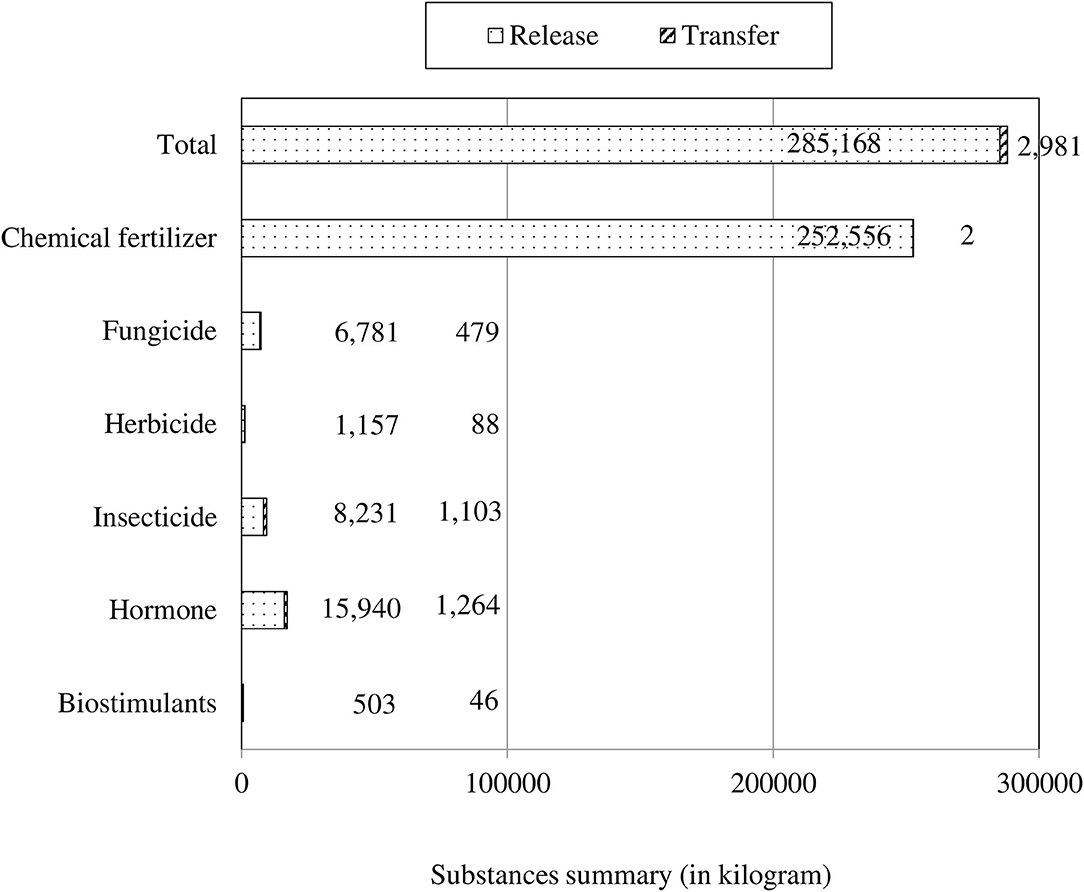
Figure 2. Summary of substance release and transfer during off-season durian production in Krungching Sub-district, Thailand.
In terms of pollution release, the chemical fertilizer 24-4-24 was highest overall, while the highest pesticides were carbendazim (4,691 kg/yr) and abamectin (2,690 kg/yr) (Table 2). Three herbicides were commonly applied: paraquat (49%), glyphosate (12%), and pyrethrin (11%). However, some farmers used the combinations paraquat-glyphosate (8%) and paraquat-pyrethrin (8%). The pollution releases of paraquat and glyphosate were 932.2 and 224.5 kg/yr, respectively, while their pollution transfers by off-site waste disposal were only 7.5 and 5.1%. In other words, their ratios of on-site to off-site pollution release were 12:1 and 19:1, respectively.
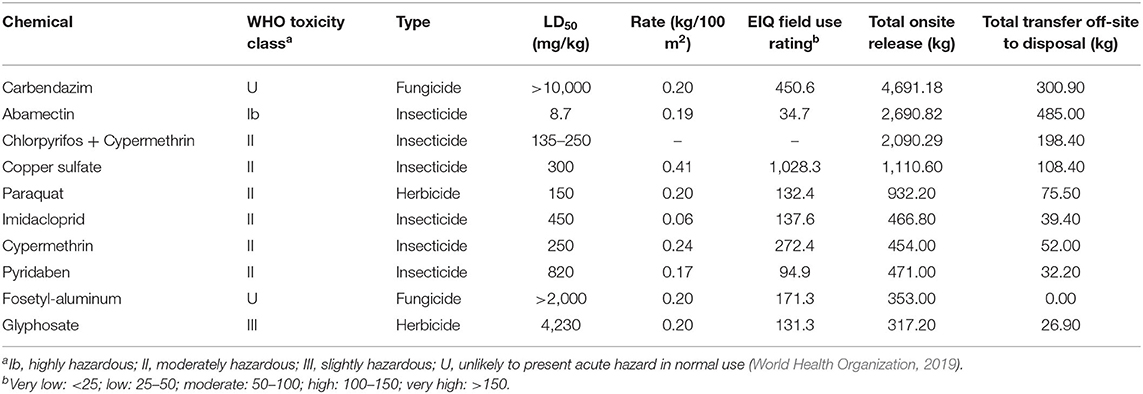
Table 2. Top ten pesticides in terms of on-site release and off-site transfer from non-point pollution sources related to off-season durian production in Krungching Sub-district, Thailand.
Chemical retailers significantly influenced off-season durian farmers' decisions to increase crop yield and weed control using agrochemicals. The surveyed farmers applied glyphosate and paraquat year-round because weeds are one of the strongest constraints on agriculture in the humid tropics. Herbicide was frequently used by >1/3 of farmers in Krungching Sub-district. Since off-season durian is mostly rainfed in this area, many farmers were prompted to combine herbicides to combat high weed proliferation. However, over time this pesticide abuse (over-dosing and using banned herbicide) could lead to other negative effects on the environment.
Environmental impact quotient (EIQ) models allow easy estimations of the environmental impacts of different agrochemical choices and combinations. The calculated EIQ field-use rating values for the top ten widely used agrochemicals in off-season durian production in the study area ranged from 34.7 to 1,028.3 (Table 2), with the lowest EIQ value for abamectin and the highest for copper sulfate. Eighty percentage of the top ten agrochemicals had high usage and a very high impact on the environment. Based on World Health Organization (2019) pesticide classifications, 60% were moderately hazardous while the rest were highly or slightly hazardous, or unlikely to present acute hazards in normal use (World Health Organization, 2019).
In 2016, the highest pollution transfer for agricultural chemical usage occurred for abamectin (485 kg/yr), followed by carbendazim (301 kg/yr) and LaO (251 kg/yr). Hazardous waste management methods included 26.15% on-site treatment (disposal on the land, 1,148,120 kg/yr or 25.97%; reuse, 4,860 kg/yr or 0.11%; and open burning, 3,020 kg/yr or 0.07%) and 73.85% off-site treatment (sales to Saleng, people who roam the street on tricycles collecting used materials and waste). The utilization rate of chemical fertilizer was 49,468.7 kg/km2, followed by hormones and insecticides at 3,162.5 and 2,650.0 kg/km2, respectively (Table 3).
Although Thailand currently has no non-point source inventory reporting system (Thailand Pollution Control Department, 2010), our results show that a lack of a real-time agrochemical use database is a major impediment to implementing appropriate measures toward substantially reducing impacts on application sites and downstream ecosystems. Moreover, agriculture activities (especially off-season durian production) are diverse and inconsistent due to widespread difference in agrochemicals application practices by farmers. Therefore, it is important to start gradual evaluations of non-point emission sources and inventories of pollutants released and transferred from off-season durian production. Such programs could help relevant local or state agencies design improved environmental monitoring programs for pollution from these sources and other major export crops. In addition, this could increase farmers' environmental awareness with shared benefits for farmers and the environment, helping sustain ecosystems in areas with intensive agrochemical usage.
We found that a major agricultural exporting country, Thailand, needs to create a more consolidated uniform system to collect the current status of agrochemical release and use at the farm level. The collection of sales data can be used as a substitute for a survey of usage data. One of the explicit advantages is that sales data are much cheaper to collect, and collection can therefore be performed annually. However, sales data are rarely available at the active level and contain no information about the crop, timing, and regional variation in use, dose applied, and number of applications to the crop or percentage of crop treated. In parallel with sales data, we propose the survey of data on farmers' actual use of agrochemical by postal or e-mail surveys Postal surveys can be structured in such a way that questionnaires are sent out several times during the year when pesticide applications are likely to have occurred. This will remind the grower to fill in the form at a time when the information required is fresh in his memory and reduces the burden of filling in a form with all the details at the end of the growing year. Before the survey begins, farmers may be asked by post whether they still grow the crop covered by the survey and whether they will take part in the survey. If they agree, at the beginning of each month they are sent a questionnaire that is tailored to that crop and which reflects the practices likely to be undertaken during the following month. The actual usage data have provided the foundation for the development of residue monitoring follow-up, and to see where current practices can be improved or optimized.
Characteristics of Paraquat and Glyphosate Residue in Surface Water
The glyphosate and paraquat concentrations in stream water varied by season, with both being found during summer but not during the rainy season (Table 4). Overall, the former occurred in 83.3% of samples and the latter in 66.7%. Paraquat concentrations varied from <1 46.849 μg/L. All water samples with detectable paraquat concentrations showed higher values than Canadian drinking water guidelines (paraquat dichloride <10μg/L) (Health Canada, 2021).
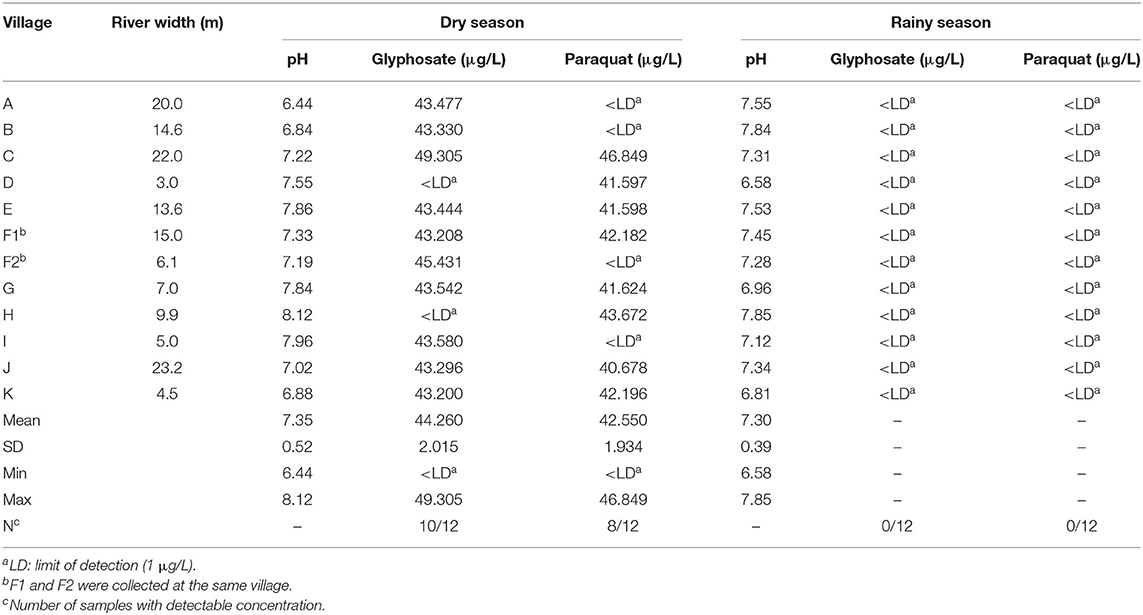
Table 4. Concentrations of the herbicides paraquat and glyphosate in a stream flowing through 11 villages in Krungching Sub-district, Thailand (n = 24).
Glyphosate was detected at relatively high concentrations in agricultural areas, ranging from <1 to 49.305 μg/L. Although glyphosate was detected at many sites, its concentrations did not exceed the 280 μg/L value established by the Canadian drinking water guidelines (Health Canada, 2021). The average concentrations of glyphosate and paraquat were 44.260 and 42.550 μg/L, respectively, tending to be the highest during the dry season due to extensive herbicide use for land preparation and low rainfall. Likewise, rain-induced increases in river caused herbicide transport from direct areas of influence to downstream sites, increasing glyphosate levels at those points. The observed seasonal variations in glyphosate matched observations in French surface waters from 2013 to 2017, where seasonal fluctuations in glyphosate concentrations peaked in spring/summer shortly after pesticide application (Carles et al., 2019).
Concentrations of both paraquat and glyphosate in the study area were much higher than those of river water in Chanthaburi Province, Eastern Thailand, where most land is used to produce a wide variety of fruits. For example, paraquat concentrations in the Chanthaburi River ranged from 0.13–7.13 to 0.07–13.05 μg/L in the dry and wet seasons, respectively (Pataranawat et al., 2012). Similarly, paraquat concentrations in the study area were also higher than those reported for other regions of the world, such as marshes in Valencia, Spain (0.19–3.95 μg/L) (Fernandez et al., 1998) and stream water in an intensively agricultural part of Rio de Janeiro, Brazil (average 0.075 μg/L, maximum 0.279 μg/L) (Britt et al., 2003).
While flowing water can be a major factor contributing to herbicide movement in the environment, leaching can also result after extensive rainfall or irrigation, moving chemicals from the topsoil deeper into the soil profile. In general, both glyphosate and paraquat bind very tightly to most soils and sediments in the environment (Koc of 300–20,100 and Kd > 10,000, respectively) and thus have low potential to move through soil and contaminate water (Britt et al., 2003). For this reason, glyphosate and paraquat residues are only found in limited amounts in surface water as a result of runoff (concentrations typically <100 ng/L) (Covaci, 2014). Studies examining the fate of glyphosate over several years have found that <1% of the glyphosate amount applied was lost as runoff from agricultural fields. In several provinces of Indonesia with different agricultural emphases (e.g., palm oil, rice, or corn), paraquat residues were found in the soil but not in the surface water or below the detection limit (0.0569 μg/L). Similarly, Cheah et al. (1998) reported that paraquat was rapidly adsorbed onto sediment. In general, low paraquat concentrations in water bodies are commonly observed during drought periods due to the absence of surface runoff caused by rainfall.
In rivers, the dissipation time necessary to eliminate 50% (DT50) of glyphosate varies from 13.8–301 d, suggesting moderate to high persistence (European Food Safety Authority, 2015). The paraquat and glyphosate concentrations in this study were remarkably higher than those in other studies, demonstrating high levels of overspray or runoff from agricultural drainage ditches. Soils collected from the study area consisted of silt with low clay content. Silt tends to have a lower cation exchange capacity than clay; that in the study area ranged from 3.07 to 6.44 cmol/kg (Thailand Land Development Department, 2021). In addition, the half-life of glyphosate can be prolonged in the environment due to the formation of metal complexes with highly chelating cations (e.g., Cu+2 and Fe+2), which significantly reduce its availability for microbial decomposition (Tsui et al., 2005). We recommend regular monitoring of contamination in the study area where heavy use and potential mobility are risks, in order to provide context for improved control of agricultural chemical usage, farming practices, and environmental awareness.
Sustainable Agricultural Chemical Management for Off-Season Durian
Our survey of farmers from 11 villages in Krungching Sub-district found that glyphosate and paraquat were the most commonly used herbicides. Pesticides were used in every step of off-season durian production. A hazard quotient (HQ) analysis using a screening benchmark based on Canadian water criteria set for the protection of freshwater aquatic life (established by that country's Council of Ministers of the Environment) suggested no potential environmental risks in the dry or rainy seasons at any sites where HQ < 0.1 and low hazardous effects where HQ was 0.1–1.0. However, pesticide management in Thailand lacks a uniform management and tracking system, requiring new ways to facilitate better management and use of pesticides. In addition, most pesticides used are highly hazardous, including Classes I and II (Chalermphol and Shivakoti, 2009).
The domestic market for pesticides in Thailand (e.g., advertisement, use of trade names, or sale restrictions) is competitive. Due to a large number of unlicensed retailers, much of the misuse and mishandling of pesticides in domestic trading occurs after the point of sale, leaving pesticide use largely uncontrolled (Panuwet et al., 2012). The DOA requires that the use of pesticides with high acute toxicity (LD50 < 30 mg/kg) be evaluated through surveillance. Presently, both glyphosate (LD50 < 5,000 mg/kg) and paraquat (LD50 110–150 mg/kg) are under evaluation and the DOA is considering bans or severe restrictions. In addition, it has recognized that the overuse of pesticides as a problem and is attempting to make farmers cognizant of regulatory controls and proper pesticide use by launching mitigation campaigns encouraging organic farming and other good agricultural practices, and promoting the use of bio-pesticides. However, most farmers still believe that pesticide application is necessary, leading to their continued use in large amounts. Good record/inventory practices could also help match the monitoring frequency to off-season fruit production periods during which potentially harmful environmental impacts occur, leading to human health risks.
We used field observations of off-season durian production and survey data to delineate six relevant periods (Table 5). Site preparation occurs in April, during which herbicide application is needed. Flowering occurs from August-September. Mature fruit harvest occurs from January to March. Immediately after harvest, durian trees must be washed to prevent egg laying by the long-horned beetle and sprayed with herbicides to prepare for next cycle production.
The persistent herbicide concentrations in the stream and the inventory of agrochemicals used for off-season durian production explain why the measured glyphosate and paraquat concentrations in surface water were higher than those reported in other regions. In areas of extensive agrochemical use, soil characteristics and tropical climatic conditions mean that upstream watershed areas with substantial off-season durian production release various agrochemicals into the environment, suggesting a greater risk of agrochemical transfer by leaching. Therefore, an agrichemical usage database network should be developed for improved load estimation, with particular attention paid to real-time mitigation, in order to prevent excessive agrichemical loads in environmental media.
However the finding that misuse and overuse of agrochemical is certainly not unique to off-season durian production and can be generalized to diversification into high value crops of Thailand. Results showed that the majority of farmers are dependent on agrochemical dealers or company representatives for information on crop protection. Therefore, this network can be effectively used for regular flow of agrochemical load information. The automatically and updated network agrochemical inventory should be accessed by all relevant stakeholder to manage chemicals throughout their life-cycles and to assist farmers in making correct decisions for the safe and judicious use of agrochemical at the farm level.
Conclusions
We used farmer surveys to develop an inventory of agricultural chemicals used for off-season durian production, then assessed their release into environmental media (especially surface water). Our results suggest a greater risk of agrochemical transfer by leaching due to the application cycles needed for off-season fruit production. Less than 2/3 of streams in Krungching Sub-district contained residues of glyphosate, paraquat, or both. These showed seasonal fluctuations, with glyphosate concentrations increasing from the end of summer and decreasing during the rainy season, matching the pesticide application calendar. Although variations in off-season durian production practices make it difficult to predict the behavior of environmental residues for specific agricultural substances, the application of a PRTR allowed the highlighting of general trends.
Compiling data on the use of agrochemicals, hazardous containers, and emission factors is difficult, as is estimating emissions from the use phase of end-products. Currently, clear knowledge of emissions from agrochemical use on off-season crops is restricted to certain chemical groups and substances, while little is known about the actual contribution of emissions from agrochemical and fertilizer use to the total emissions of most substances/chemicals. However, we found clear that agrochemicals have now become an integral part of the off-season fruit activity especially in the major fruit exporter region, thus leaving agrochemicals use largely uncontrolled. Therefore, it is important to find effective ways to improve agrochemical management. PRTRs can contribute to environmental release inventory surveillance of harmful and potentially harmful chemicals, improving public tracking and reporting systems for pollutants. Under this protocol, facilities could be required to disclose information on their emissions and waste transport. As pesticide leaching contributes to the risk of environmental damage and undermines control measures, understanding their fate will enable better anticipation to avoid future pollution events. Such a registry will contribute to the reduction of agricultural activity emissions and waste transfers by inducing operators to reconsider their emissions and providing the public with information allowing pressure on operators to reduce emissions. We recommend further research combining PRTR methods and in situ monitoring to assess the current and future effects of agrochemical use in tropical off-season durian systems on water resources. This combined approach has interesting potential for adjusting cropping systems in cooperation with farmers responsible for food safety.
Data Availability Statement
The original contributions presented in the study are included in the article/supplementary material, further inquiries can be directed to the corresponding author.
Ethics Statement
The studies involving human participants were reviewed and approved by human research ethics committee of Walailak University. The patients/participants provided their written informed consent to participate in this study.
Author Contributions
PP supervised the project, contributed to the interpretation of the results, and wrote the manuscript. PP and SJ planned and carried out the data collection and create data visualization.
Funding
The work was financially supported by the Thai Government Budget 2017/2018 (National Research Council of Thailand) and Walailak University (Finance Code WU60111 and WU60112).
Conflict of Interest
The authors declare that the research was conducted in the absence of any commercial or financial relationships that could be construed as a potential conflict of interest.
Publisher's Note
All claims expressed in this article are solely those of the authors and do not necessarily represent those of their affiliated organizations, or those of the publisher, the editors and the reviewers. Any product that may be evaluated in this article, or claim that may be made by its manufacturer, is not guaranteed or endorsed by the publisher.
Acknowledgments
The authors wish to thank the Thai government and Walailak University for financial support. We are particularly grateful to the farmers of Krungching Sub-district for their cooperation.
References
Britt, C., Mole, A., Kirkham, F., and Terry, A. (2003). The Herbicide Handbook: Guidance on the Use of Herbicides on Nature Conservation Sites. Wetherby: English Nature.
Carles, L., Gardon, H., Joseph, L., Sanchís, J., Farré, M., and Artigas, J. (2019). Meta-analysis of glyphosate contamination in surface waters and dissipation by biofilms. Environ. Int. 124, 284–293. doi: 10.1016/j.envint.2018.12.064
Chalermphol, J., and Shivakoti, G. P. (2009). Pesticide use and prevention practices of tangerine growers in northern Thailand. J. Agric. Educ. Ext. 15, 21–38. doi: 10.1080/13892240802617429
Cheah, U. B., Kirkwood, R. C., and Lum, K. Y. (1998). Degradation of four commonly used pesticides in Malaysian agricultural soils. J. Agric. Food Chem. 46, 1217–1223. doi: 10.1021/jf970579t
Covaci, A. (2014). “Environmental fate and behaviour,” in Encyclopedia of Toxicology, 3rd Edn, ed Wexler, P. (Waltham: Academic Press), 372–374. doi: 10.1016/B978-0-12-386454-3.01041-1
Datawheel (2021). Tropical Fruits. Available online at: https://oec.world/en/profile/hs92/tropical-fruits (accessed May 24, 2021).
European Food Safety Authority (2015). Conclusion on the peer review of the pesticide risk assessment of the active substance glyphosate. EFSA J. 13:11. doi: 10.2903/j.efsa.2015.4302
Fernandez, M., Ibanez, M., Pico, Y., and Manes, J. (1998). Spatial and temporal trends of paraquat, diquat, and difenzoquat contamination in water from marsh areas of the valencian community (Spain). Arch. Environ. Contam. Toxicol. 35, 377–384. doi: 10.1007/s002449900391
Fröhlich, H. L., Schreinemachers, P., Stahr, K., and Clemens, G. (2013). Sustainable Land Use and Rural Development in Southeast Asia: Innovations and Policies for Mountainous Areas. Heidelberg: Springer. doi: 10.1007/978-3-642-33377-4
Gebska, M., Grontkowska, A., Swiderek, W., and Golebiewska, B. (2020). Farmer awareness and implementation of sustainable agriculture practices in different types of farms in Poland. Sustainability. 12, 1–17. doi: 10.3390/su12198022
Hau, T. V., and Hieu, T. S. (2017). Off-season production of durian in the Mekong delta, Vietnam. Acta Hortic. 1186, 85–98. doi: 10.17660/ActaHortic.2017.1186.13
Health Canada. (2021). Guidelines for Canadian Drinking Water Quality-Paraquat. Available online at: https://www.canada.ca/en/health-canada/services/publications/healthy-living/guidelines-canadian-drinking-water-quality-guideline-technical-document-paraquat.html (accessed May 15, 2021).
Kroma, M. M. (2006). Organic farmer networks: Facilitating learning and innovation for sustainable agriculture. J. Sustain. Agric. 28, 5–28. doi: 10.1300/J064v28n04_03
Legal Information Institute. (2021). Toxic Chemical Release Reporting Form and Instructions. Available online at: https://www.law.cornell.edu/cfr/text/40/372.85 (accessed May 17, 2021).
Mahmoud, C., and Shively, G. (2004). Agricultural diversification and integrated pest management in Bangladesh. Agric. Econ. 30, 187–194. doi: 10.1111/j.1574-0862.2004.tb00187.x
Mendes, K. F., Paula, A., Régo, A. P. J., Takeshita, V., and Tornisielo, V. L. (2019). “Water resource pollution by herbicide residues,” in Organic Pollutants, ed Ince, M. (London: IntechOpen), 1–16.
Panuwet, P., Siriwong, W., Prapamontol, T., Ryan, P. B., Fiedler, N., Robson, M. G., et al. (2012). Agricultural pesticide management in Thailand: situation and population health risk. Environ. Sci. Policy 17, 72–81. doi: 10.1016/j.envsci.2011.12.005
Pataranawat, P., Kitkaew, D., and Suppaudom, K. (2012). Paraquat contaminations in the Chanthaburi river and vicinity areas, Chanthaburi province, Thailand. J. Sci. Tech. Hum. 10, 17–24.
Sacchettini, G., Calliera, M., Marchis, A., Lamastra, L., and Capri, E. (2012). The stakeholder-consultation process in developing training and awareness-raising material within the framework of the EU directive on sustainable use of pesticides: the case of the EU-project BROWSE. Sci. Total Environ. 438:1, 278–285. doi: 10.1016/j.scitotenv.2012.08.079
Schreinemachers, P., Wu, M. H., Uddin, M. N., Ahmad, S., and Hanson, P. (2016). Farmer training in off-season vegetables: Effects on income and pesticide use in Bangladesh. Food Policy 61, 132–140. doi: 10.1016/j.foodpol.2016.03.002
Smith, A. K., and Pollard, D. A. (1998). Policy and Guidelines: Aquatic Habitat Management and Fish Conservation in 1998. Sydney: NSW Fisheries.
Statista (2021). Thailand: Share of Economic Sectors in the Gross Domestic Product (GDP) From 2009 to 2019. Available online at: https://www.statista.com/statistics/331893/share-of-economic-sectors-in-the-gdp-in-thailand (accessed May 25, 2021).
Sudi, I. Y. (2017). Assessment of herbicides and pesticides residues in Gella surface water. Asian J. Adv. Agric. Res. 3, 1–9. doi: 10.9734/AJAAR/2017/36785
Šumane, S., Kunda, I., Knickel, K., Strauss, A., Tisenkopfs, T., Rios, I. D. I., et al. (2018). Local and farmers' knowledge matters! How integrating informal and formal knowledge enhances sustainable and resilient agriculture. J. Rural Stud. 59, 232–241. doi: 10.1016/j.jrurstud.2017.01.020
Thailand Department of Agriculture (2021). Durian Seasons in Durian Production Areas. Available online at: https://www.saranukromthai.or.th/sub/book/book.php?book=28&chap=4&page=chap4.htm (accessed May 22, 2021).
Thailand Land Development Department (2021). Soil Resource Management of for Cultivation of Economic Crops by Soil Series. Available online at: http://e-library.ldd.go.th/library/flip/bib404f/bib404f.html#p=5 (accessed March 17, 2021).
Thailand Ministry of Agriculture Cooperatives (2021). Thailand Important Agricultural Situations and Trends 2021. Available online at: http://www.oae.go.th/assets/portals/1/ebookcategory/57_trend-2564/#page=124 (accessed May 22, 2021).
Thailand Pollution Control Department (2010). Thailand State of Pollution Report 2010. Bangkok: BTS press.
Trading Economics (2021). Thailand - Employment in Agriculture. Available online at: https://tradingeconomics.com/thailand/employment-in-agriculture-percent-of-total-employment-wb-data.html (accessed May 24, 2021).
Tsui, M. T. K., Wang, W. X., and Chu, L. M. (2005). Influence of glyphosate and its formulation (Roundup) on the toxicity and bioavailability of metals to Ceriodaphnia dubia. Environ. Pollut. 138, 59–68. doi: 10.1016/j.envpol.2005.02.018
United Nations. (2021). Global Indicator Framework for the Sustainable Development Goals and Targets of the 2030 Agenda for Sustainable Development. Available online at: http://www.fao.org/sustainable-development-goals/indicators/241/en/ (accessed May 22, 2021).
World Health Organization. (2019). The WHO Recommended Classification of Pesticides by Hazard and Guidelines to Classification 2019. Available online at: https://www.who.int/publications/i/item/9789240005662 (accessed May 20, 2021).
Keywords: agrochemical inventory, glyphosate, paraquat, herbicide, surface water, off-season durian
Citation: Pibul P and Jawjit S (2021) Agrochemical Usage Inventory and Measured Residues in Streams Within an Off-Season Durian Production Region of Thailand. Front. Sustain. Food Syst. 5:731973. doi: 10.3389/fsufs.2021.731973
Received: 28 June 2021; Accepted: 30 July 2021;
Published: 25 August 2021.
Edited by:
Zainul Akmar Zakaria, University of Technology Malaysia, MalaysiaReviewed by:
Chanthima Phungamngoen, King Mongkut's University of Technology North Bangkok, ThailandHeru Irianto, Sebelas Maret University, Indonesia
Saiful Irwan Zubairi, National University of Malaysia, Malaysia
Copyright © 2021 Pibul and Jawjit. This is an open-access article distributed under the terms of the Creative Commons Attribution License (CC BY). The use, distribution or reproduction in other forums is permitted, provided the original author(s) and the copyright owner(s) are credited and that the original publication in this journal is cited, in accordance with accepted academic practice. No use, distribution or reproduction is permitted which does not comply with these terms.
*Correspondence: Panatda Pibul, cHBpYnVsQGdtYWlsLmNvbQ==
 Panatda Pibul
Panatda Pibul Siriuma Jawjit
Siriuma Jawjit